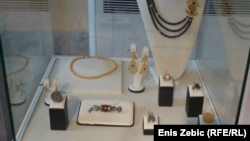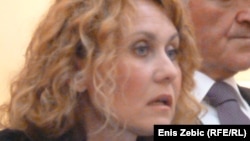ZAGREB -- Croatia is throwing open the doors to 214 museums and cultural institutions for its annual Night of Museums, a chance for residents to enjoy an evening of free art.
The star attraction, however, is not Croatian, but Bosnian -- a valuable collection of ancient and antique jewelry on loan for one night from Sarajevo's National Museum.
"This is an exhibition of some 60 pieces of selected jewelry that span an extremely long period of time, from the fourth century B.C. to the beginning of the 20th century," says Arijana Koprcina, who's curating the exhibition, which will be held at the Mimara art museum in the Croatian capital, Zagreb. "And it includes the two biggest and most important departments of that very large museum, archaeological and ethnographic."
The exhibit is a rare outing for the Bosnian jewels, which have spent more than a year out of public view after the museum was closed amid a heated debate over who, in multiethnic Bosnia-Herzegovina, should fund a "national" museum.
Bosnia's unique postwar government -- mapped out in in the 1995 Dayton accords -- hands the bulk of power to local, ethnically determined bodies, leaving only a weak central government with limited budget control to deal with overarching national issues like culture.
As funding evaporated, the National Museum -- whose treasures include the Sarajevo Haggadah, a 650-year-old illuminated manuscript worth an estimated $700 million -- was forced to fire its staff and eventually board up its premises in October 2012.
But many in Croatia had a soft spot for the 125-year-old Sarajevo museum, whose first curator, Ciro Truhelka, was a respected Croatian archaeologist.
Croatia's assistant culture minister, Vesna Juric-Bulatovic, says Croatian officials readily agreed to host the exhibit after being approached by Bosnian Embassy officials in Zagreb. "Since the doors of our colleagues from the National Museum of Bosnia-Herzegovina are closed, it was natural for us to propose to make the National Museum part of the Night of Museums," she says.
The event is also seen as a moneymaking opportunity, with exhibit visitors able to purchase replicas of the jewelry on display. Twenty-five percent of the proceeds will be given to the National Museum.
Milvana Arko-Pijevac, the chairwoman of the Croatian Museum Society, says she's eager to support the museum not only financially, but morally, by introducing Croats to the bountiful collections now boarded up behind museum doors.
"Of course, all of us working in museums are already aware of the importance of museums and heritage institutions," Arko-Pijevac says. "But we want to share this idea with the public at large, and use this event to involve all of Croatia in supporting the National Museum."
No Way Forward
The National Museum has repeatedly tried and failed to find creative fundraising solutions, even proposing to exhibit the Sarajevo Haggadah, the museum's biggest draw, abroad.
A member of Bosnia's preservation commission last year rejected a plan to loan the manuscript to New York's Metropolitan Museum of Art for three years, citing the unresolved status of the National Museum. (What little funding the museum does receive goes to preserving the Haggadah in a special light- and moisture-controlled box.)
WATCH: The Sarajevo Haggadah, the ultimate survivor
The protracted closure has dismayed many Bosnians, who have watched the ethnic question forestall decisions on everything from forming a government and national identity numbers to which athlete should lead the Bosnian delegation at the Sochi Winter Olympics next week.
Ahmed Buric, a Sarajevo-based publicist, says ethnic sensitivities have eclipsed national interests in nearly every aspect of life in Bosnia. "The National Museum is perhaps the best metaphor for Bosnia-Herzegovina: it's closed, with a treasure boarded up inside," Buric says. "And people are using it as a scapegoat for an old argument that no one cares about anymore."
The star attraction, however, is not Croatian, but Bosnian -- a valuable collection of ancient and antique jewelry on loan for one night from Sarajevo's National Museum.
"This is an exhibition of some 60 pieces of selected jewelry that span an extremely long period of time, from the fourth century B.C. to the beginning of the 20th century," says Arijana Koprcina, who's curating the exhibition, which will be held at the Mimara art museum in the Croatian capital, Zagreb. "And it includes the two biggest and most important departments of that very large museum, archaeological and ethnographic."
The exhibit is a rare outing for the Bosnian jewels, which have spent more than a year out of public view after the museum was closed amid a heated debate over who, in multiethnic Bosnia-Herzegovina, should fund a "national" museum.
Bosnia's unique postwar government -- mapped out in in the 1995 Dayton accords -- hands the bulk of power to local, ethnically determined bodies, leaving only a weak central government with limited budget control to deal with overarching national issues like culture.
As funding evaporated, the National Museum -- whose treasures include the Sarajevo Haggadah, a 650-year-old illuminated manuscript worth an estimated $700 million -- was forced to fire its staff and eventually board up its premises in October 2012.
READ MORE: Bosnia's National Museum, A Victim Of Dayton's Legacy
But many in Croatia had a soft spot for the 125-year-old Sarajevo museum, whose first curator, Ciro Truhelka, was a respected Croatian archaeologist.
Croatia's assistant culture minister, Vesna Juric-Bulatovic, says Croatian officials readily agreed to host the exhibit after being approached by Bosnian Embassy officials in Zagreb. "Since the doors of our colleagues from the National Museum of Bosnia-Herzegovina are closed, it was natural for us to propose to make the National Museum part of the Night of Museums," she says.
The event is also seen as a moneymaking opportunity, with exhibit visitors able to purchase replicas of the jewelry on display. Twenty-five percent of the proceeds will be given to the National Museum.
Milvana Arko-Pijevac, the chairwoman of the Croatian Museum Society, says she's eager to support the museum not only financially, but morally, by introducing Croats to the bountiful collections now boarded up behind museum doors.
"Of course, all of us working in museums are already aware of the importance of museums and heritage institutions," Arko-Pijevac says. "But we want to share this idea with the public at large, and use this event to involve all of Croatia in supporting the National Museum."
No Way Forward
The National Museum has repeatedly tried and failed to find creative fundraising solutions, even proposing to exhibit the Sarajevo Haggadah, the museum's biggest draw, abroad.
A member of Bosnia's preservation commission last year rejected a plan to loan the manuscript to New York's Metropolitan Museum of Art for three years, citing the unresolved status of the National Museum. (What little funding the museum does receive goes to preserving the Haggadah in a special light- and moisture-controlled box.)
WATCH: The Sarajevo Haggadah, the ultimate survivor
The protracted closure has dismayed many Bosnians, who have watched the ethnic question forestall decisions on everything from forming a government and national identity numbers to which athlete should lead the Bosnian delegation at the Sochi Winter Olympics next week.
Ahmed Buric, a Sarajevo-based publicist, says ethnic sensitivities have eclipsed national interests in nearly every aspect of life in Bosnia. "The National Museum is perhaps the best metaphor for Bosnia-Herzegovina: it's closed, with a treasure boarded up inside," Buric says. "And people are using it as a scapegoat for an old argument that no one cares about anymore."














